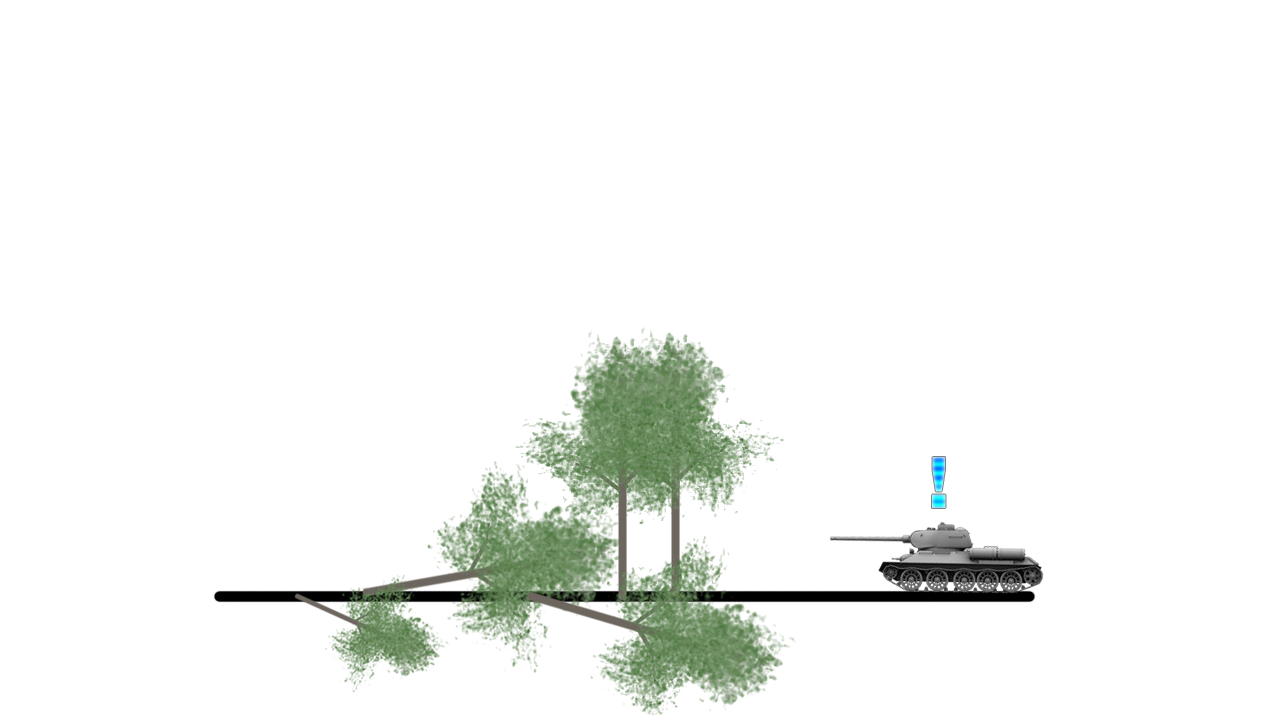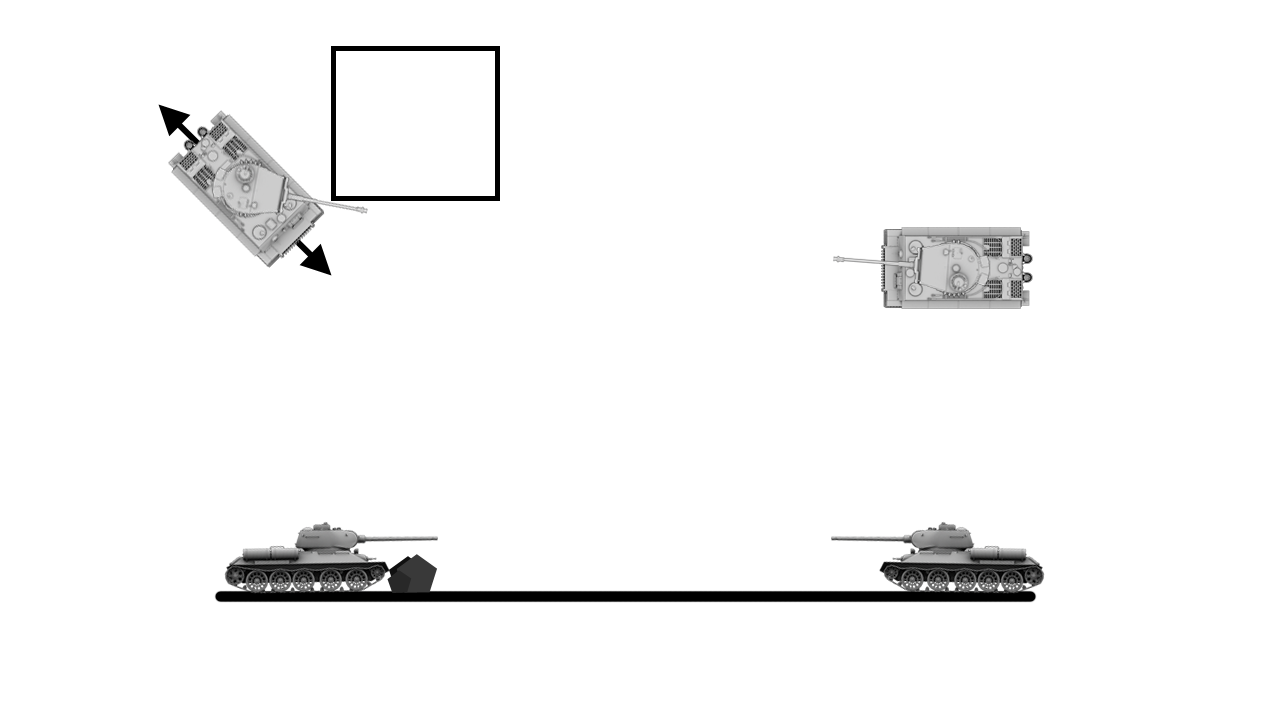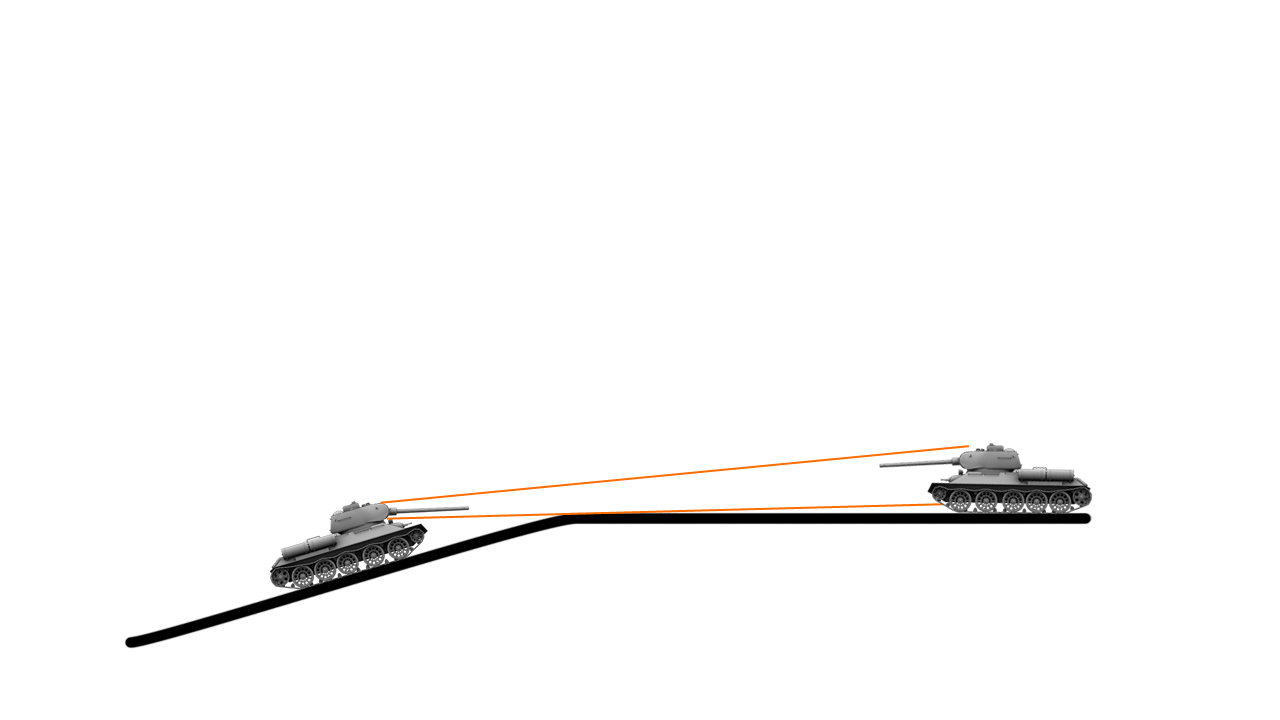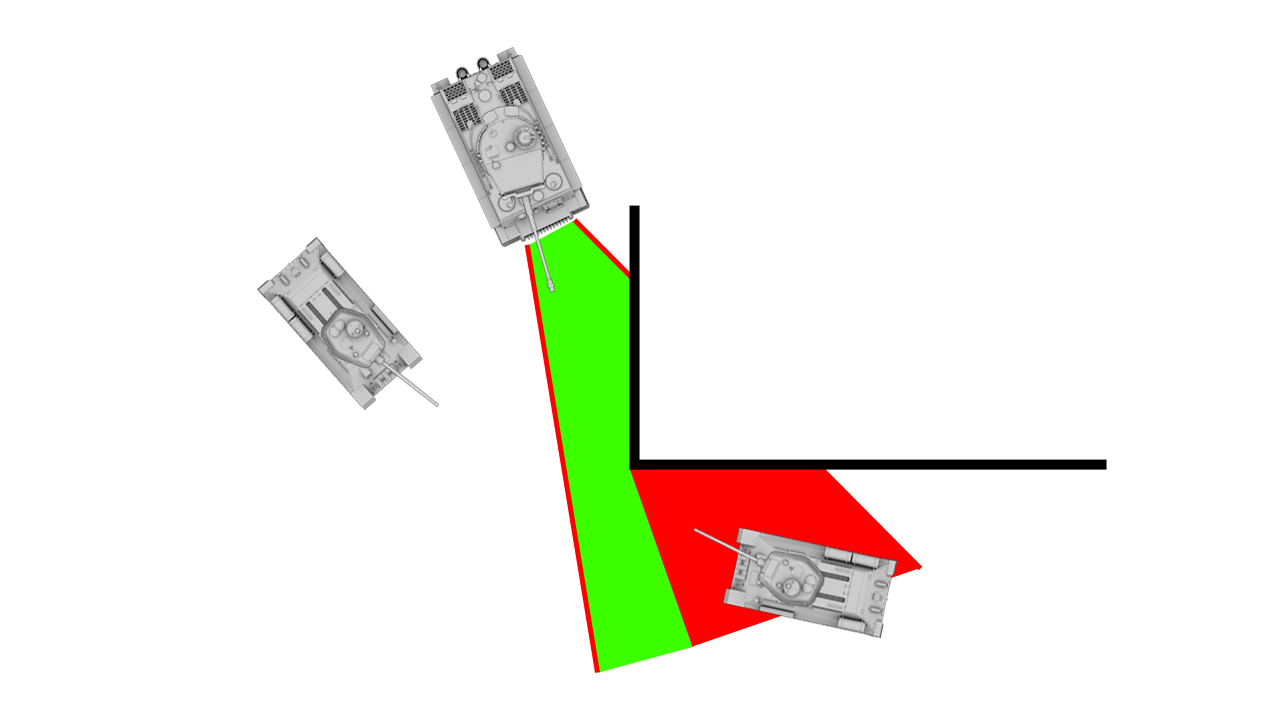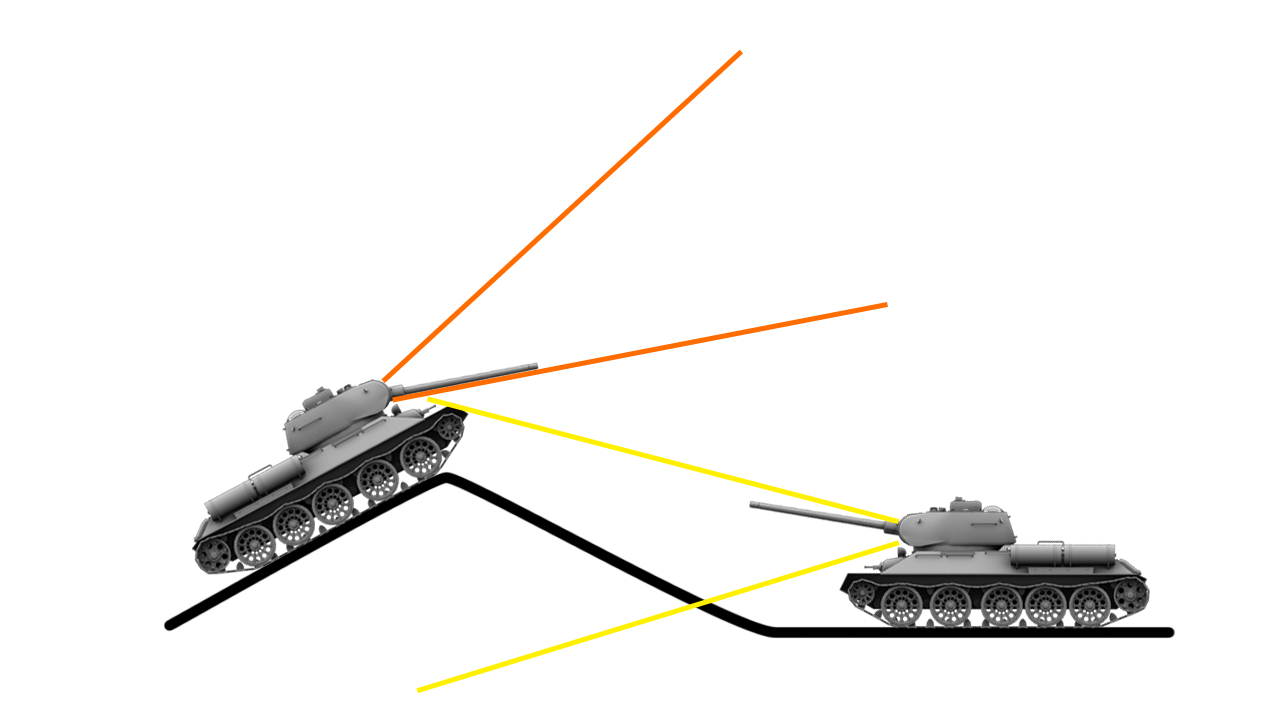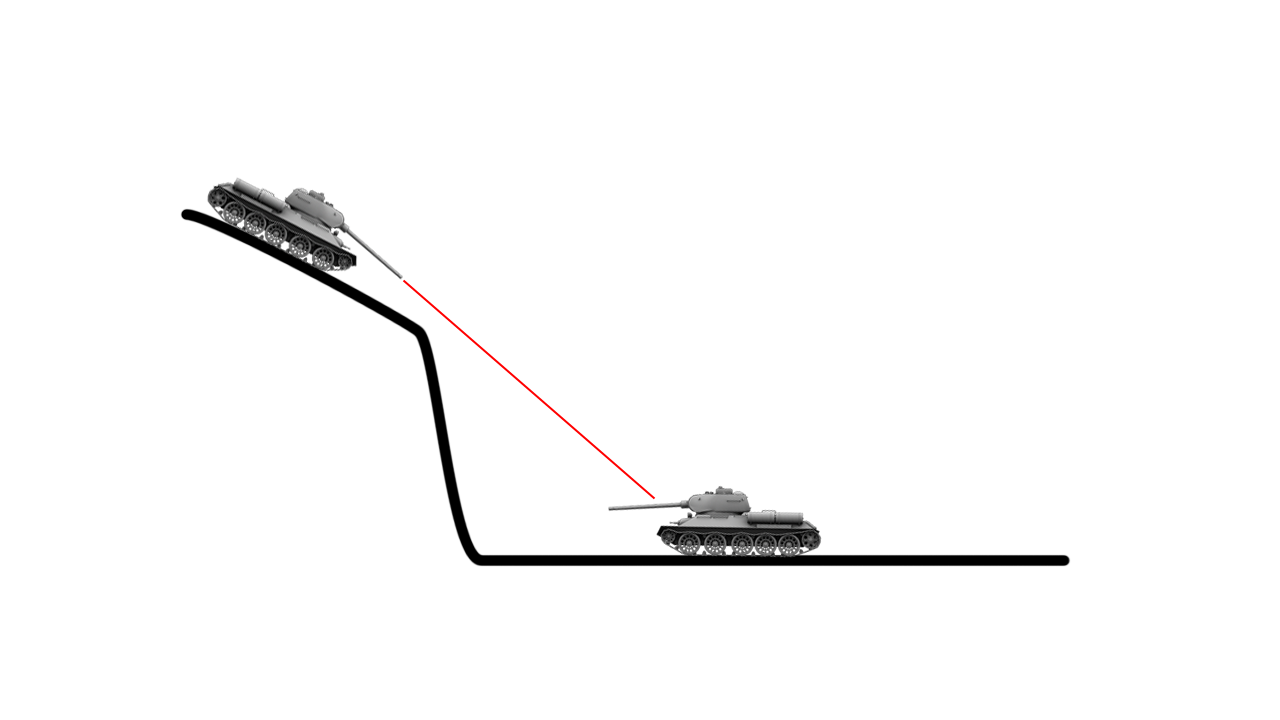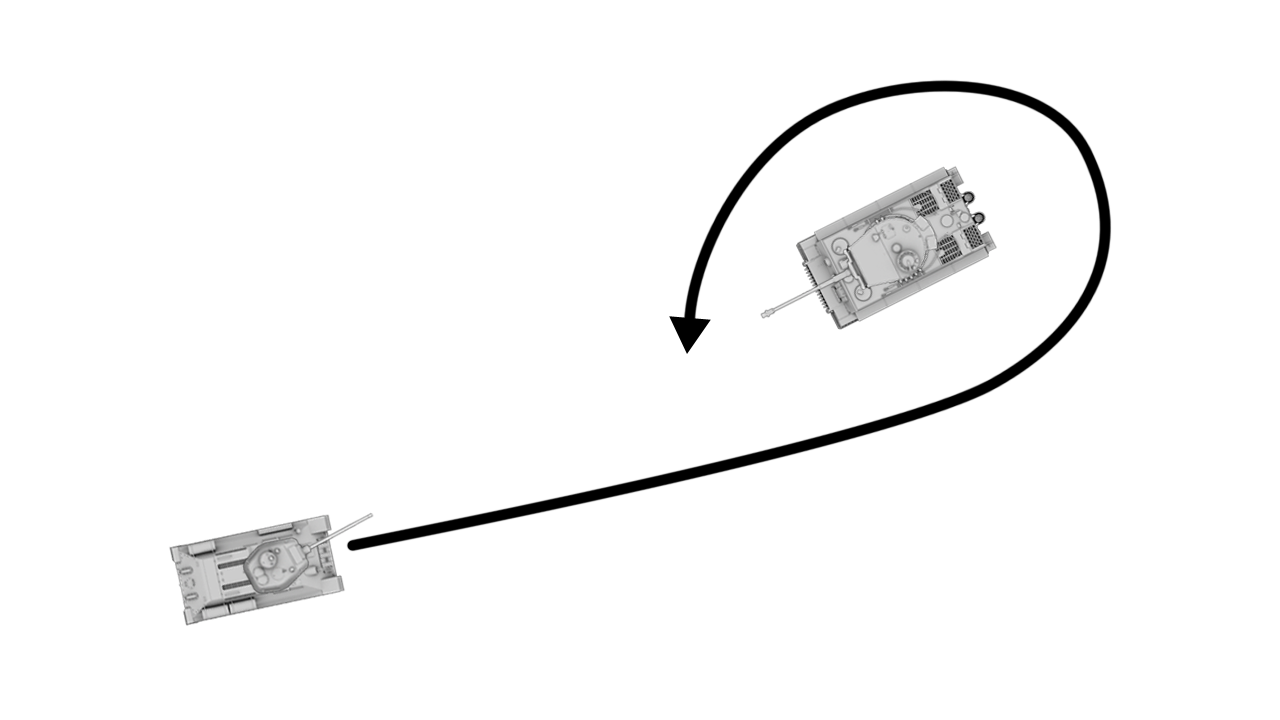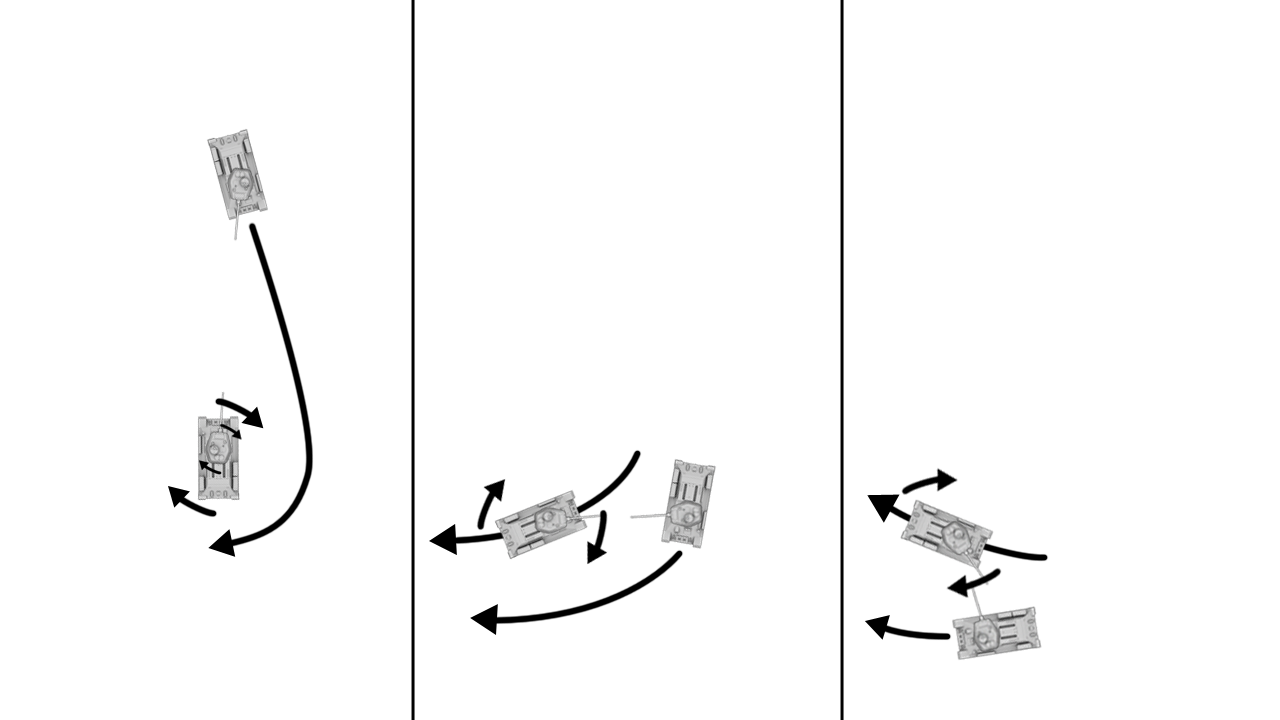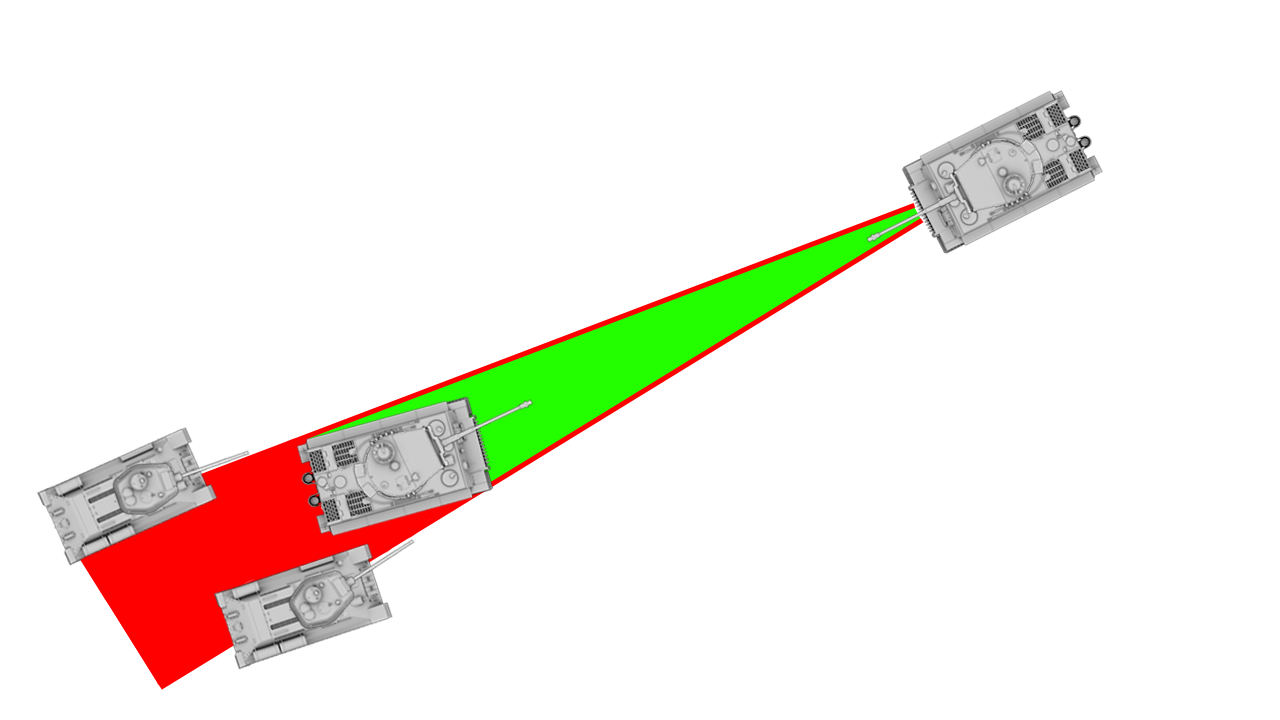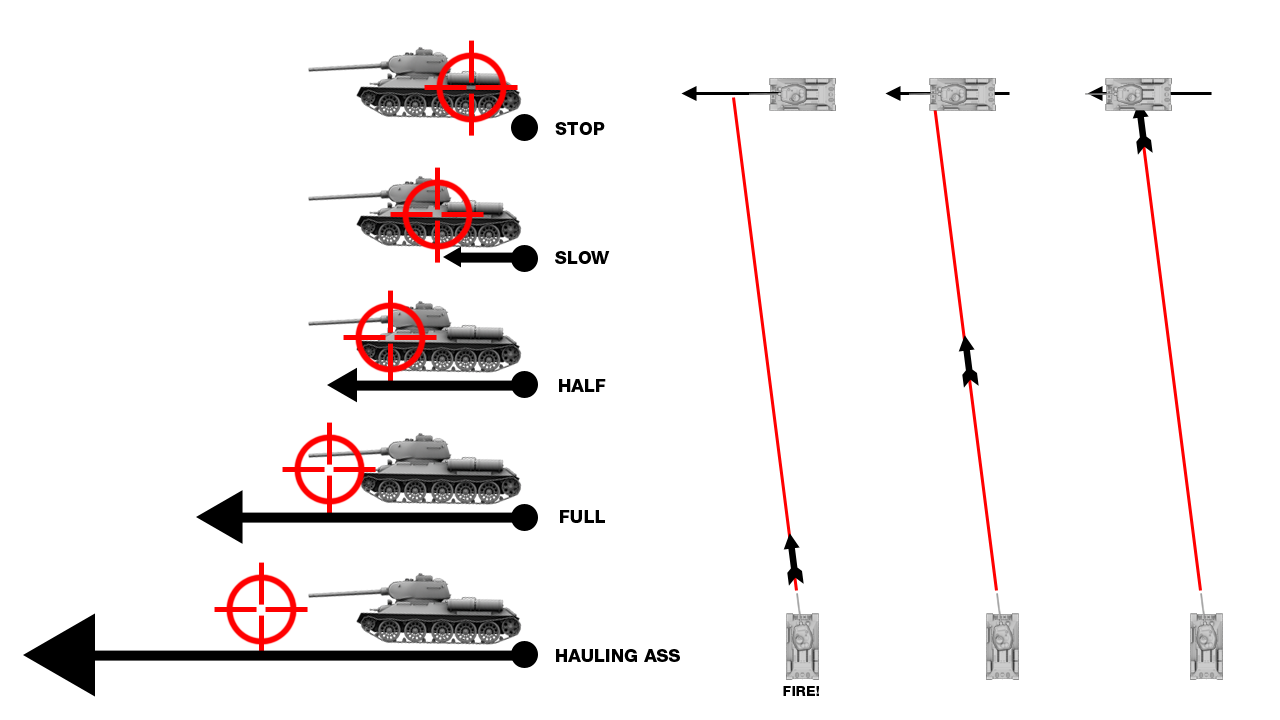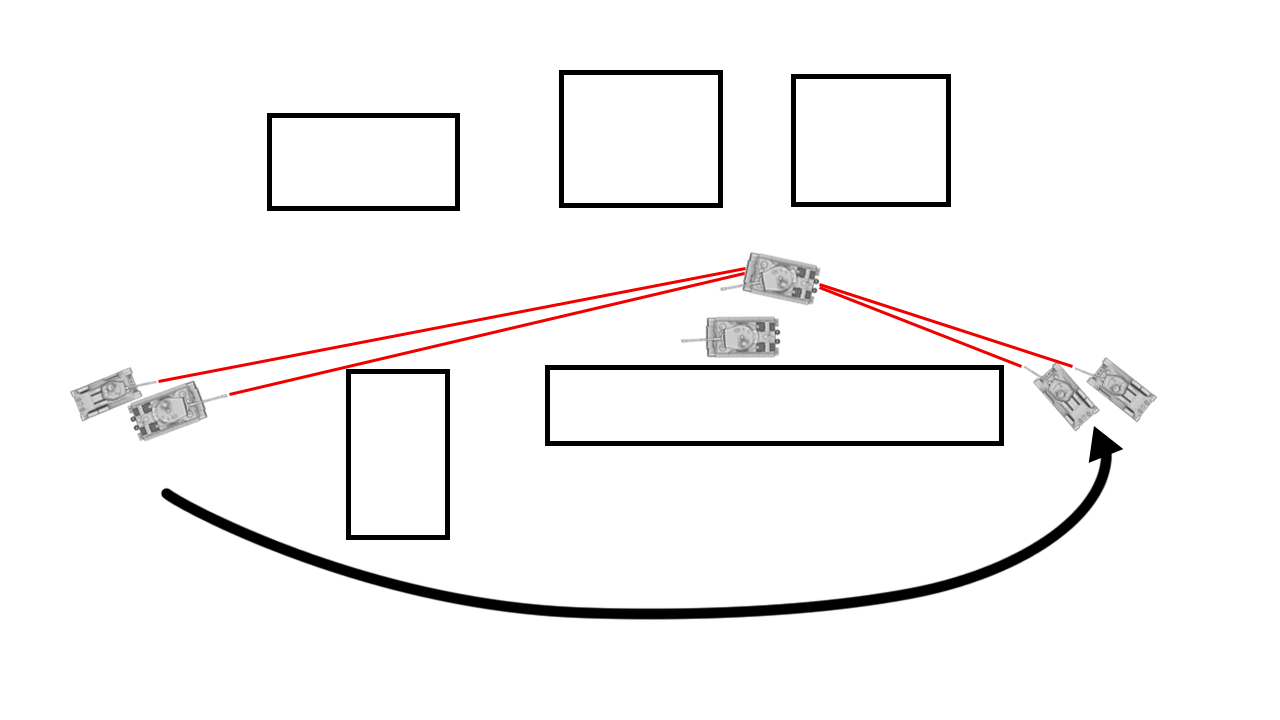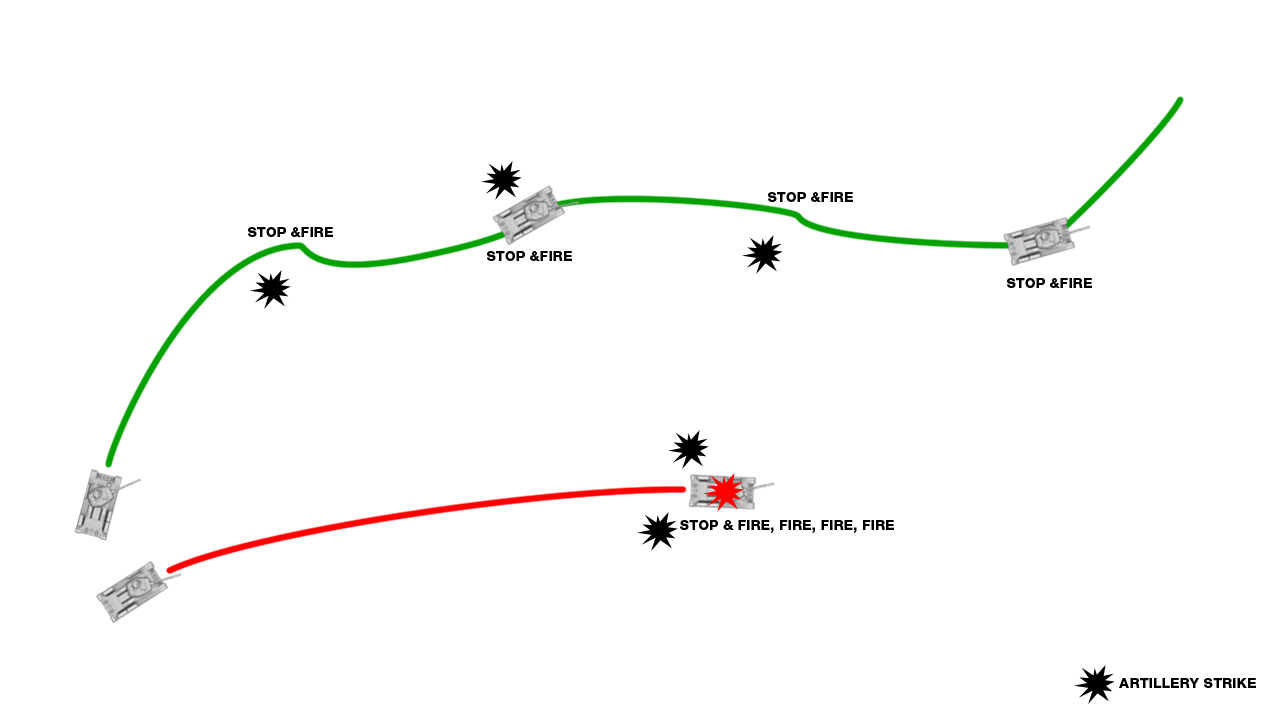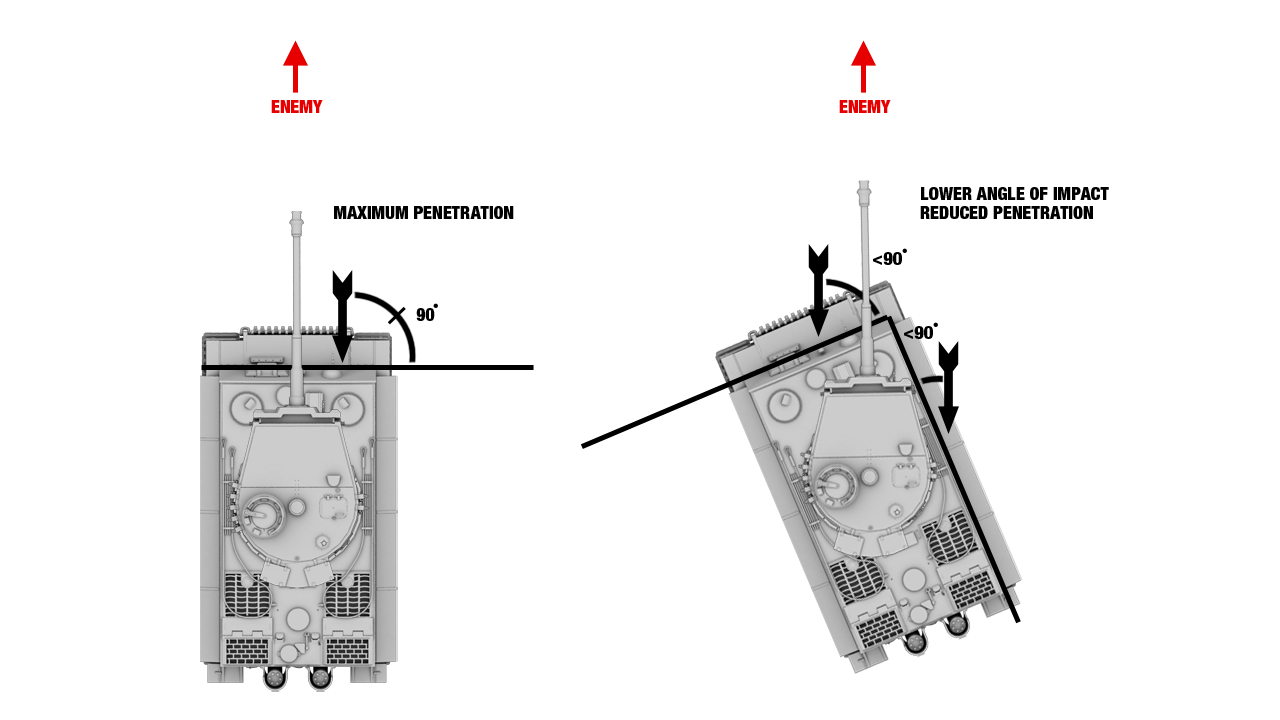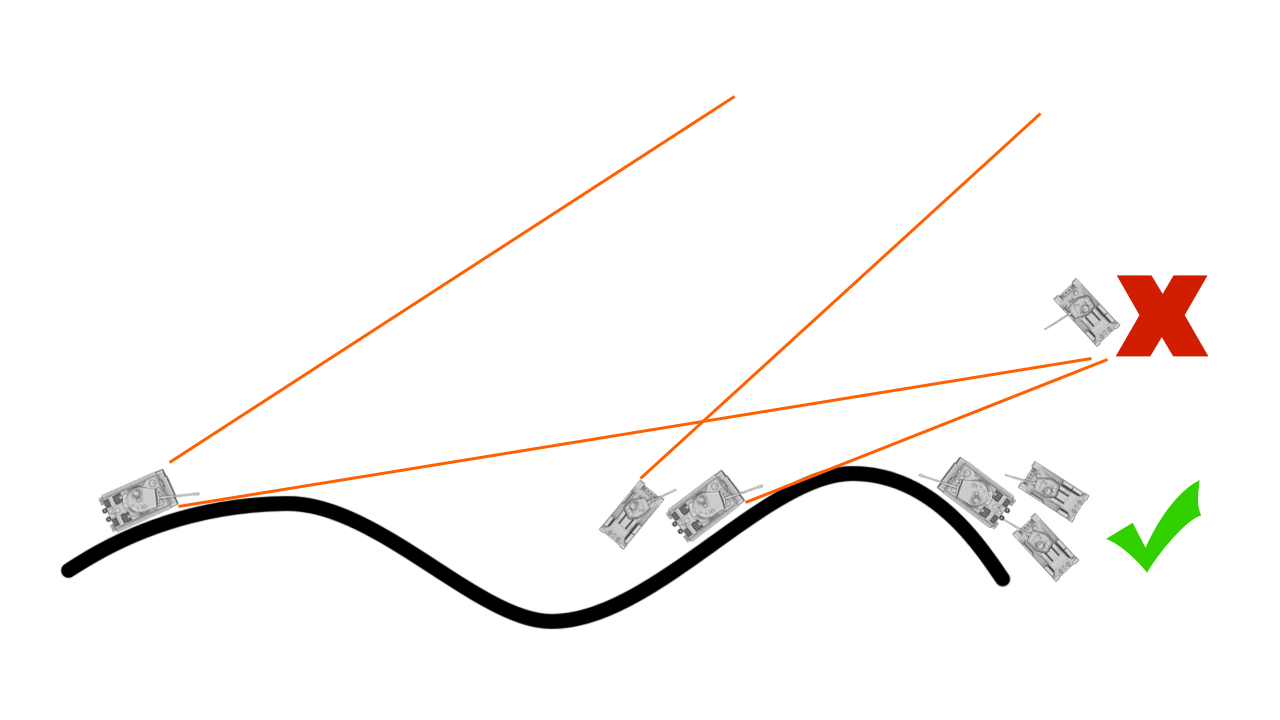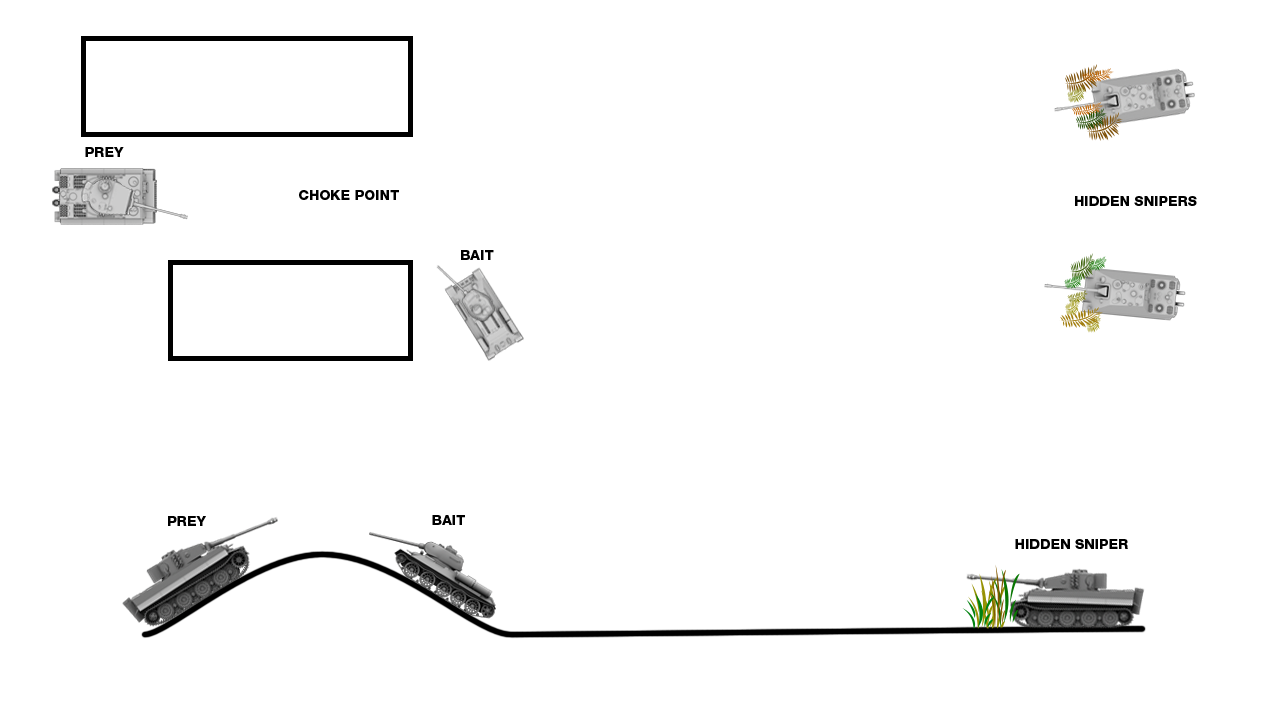Taktiken
| |
Dieser Artikel ist noch nicht vollständig übersetzt. Du kannst dem Wargaming-Wiki helfen, indem du ihn erweiterst. |
Das hier sind Standard-Panzertaktiken, die jeder Fahrer auf dem Schlachtfeld nutzen sollte.
Inhaltsverzeichnis
Situationsbewusstsein
Fahr keine Bäume um! Das verrät dem Gegner deine Position, selbst wenn er deinen Panzer nicht sehen kann und sagt der Arty, wo du dich versteckst.
Aufklärung
Aufklären ist eine wichtige Aufgabe in World of Tanks. Beim Aufklären spürt ein Panzer gegnerische Panzer auf. Diese Rolle kann theoretisch von jedem Panzer übernommen werden, aber sie wird am besten von den leichten Panzern ausgeübt. Kein anderer Panzer erreicht deren Geschwindigkeit, Sichtweite und Tarnung. Um die Rolle des Spähers zu übernehmen, muss ein Spieler mit der Spielmechanik gut vertraut sein. Ein wichtiges Merkmal eines Spähers ist eine gute Funkverbindung. Ein leichter Panzer ohne ein gutes Funkgerät ist keine Hilfe für das Team, daher sollte man sich vor dem Kampf über die Upgrades für jeden neuen leichten Panzer informieren, den man benutzt. Empfehlenswert ist es, darauf zu warten, dass die Panzerjäger und die Artillerie in Stellung gehen. Auf diese Weise hat diese Kameraden Chance, alle feindlichen Panzer auszuschalten, auf die man beim Spähtrupp stoßen könnte.
Engagement
Use the terrain to your advantage. "Fire from Cover" or "Fire and Cover" (a.k.a. "Peek-a-boo"). Find solid cover, such as a building, rock, hill or tank corpse. Duck out to fire, then pull back behind cover while reloading. This way you can deal damage and be protected while you reload.
Nutze das Gelände zu deinem Vorteil. "Feuer aus der Deckung" oder "Feuer und Deckung" (auch bekannt als "Peek-a-boo"). Finde eine solide Deckung, wie z.B. ein Gebäude, einen Felsen, einen Hügel oder eine Panzerleiche. Ducken Sie sich zum Feuern und ziehen Sie sich dann beim Nachladen in Deckung zurück. Auf diese Weise kannst du Schaden verursachen und bist beim Nachladen geschützt.
Setzen Sie sich nicht mehreren Zielen aus. Das kann alles bedeuten, von der Nutzung von Deckung, um einen Feind nach dem anderen zu konfrontieren, bis hin zum Vermeiden offensichtlicher Engpässe auf der Karte.
Tanks cresting a ridge are particularly vulnerable. They expose the weak underside of their glacis plate without being able to return fire. Tracking (destroying the tracks of) high priority tanks when they're atop the ridge allows allies to shoot them when they're exposed and helpless to retreat.
Firing from a high ridge can be risky by exposing your underside to fire, but can pay off big by hitting the soft topside of tanks.
Flankiere die schwachen Seiten und den Rücken deines Feindes, besonders gegen langsamere Ziele. Panzer haben eine schwere Panzerung vorne, eine leichtere Panzerung an den Seiten und sind hinten am schwächsten. Ein schneller mittlerer Panzer kann in der Lage sein, einen stärkeren schweren Panzer zu übertreffen, indem er ihn einfach ausmanövriert und auf seine schwächsten Punkte feuert, während er seinem langsam rotierenden Turm ausweicht. Dies ist besonders effektiv im Eins-gegen-Eins-Kampf auf offenem Gelände, wo es wenig Deckung gibt.
Beachten Sie, dass der T-34 direkt auf den Tiger zustürmt, wodurch der Tiger von den Ketten des T-34 abschießen kann. Das Flankieren im Spiel erfolgt am besten mit zwei kleineren Panzern gegen einen schwereren Panzer, so dass einer der leichteren Panzer nahe herankommen kann, während der schwere Panzer den anderen Flankierer zerstört. Auf hügeligeren Karten kann ein einzelner mittlerer Panzer einen schweren Panzer erfolgreich von der Seite flankieren, wenn er sich dem Ziel unbemerkt nähern kann.
Don't allow yourself to be flanked - one-on-one. When engaging a single enemy that's trying to flank you, continue to turn and face him while reversing. This will force him to make a wider turn than you, exposing his weaker side armor while he must penetrate your thick front armor. This is especially important when driving non-turreted tank destroyers, which have thick frontal armor and a fixed, powerful cannon.
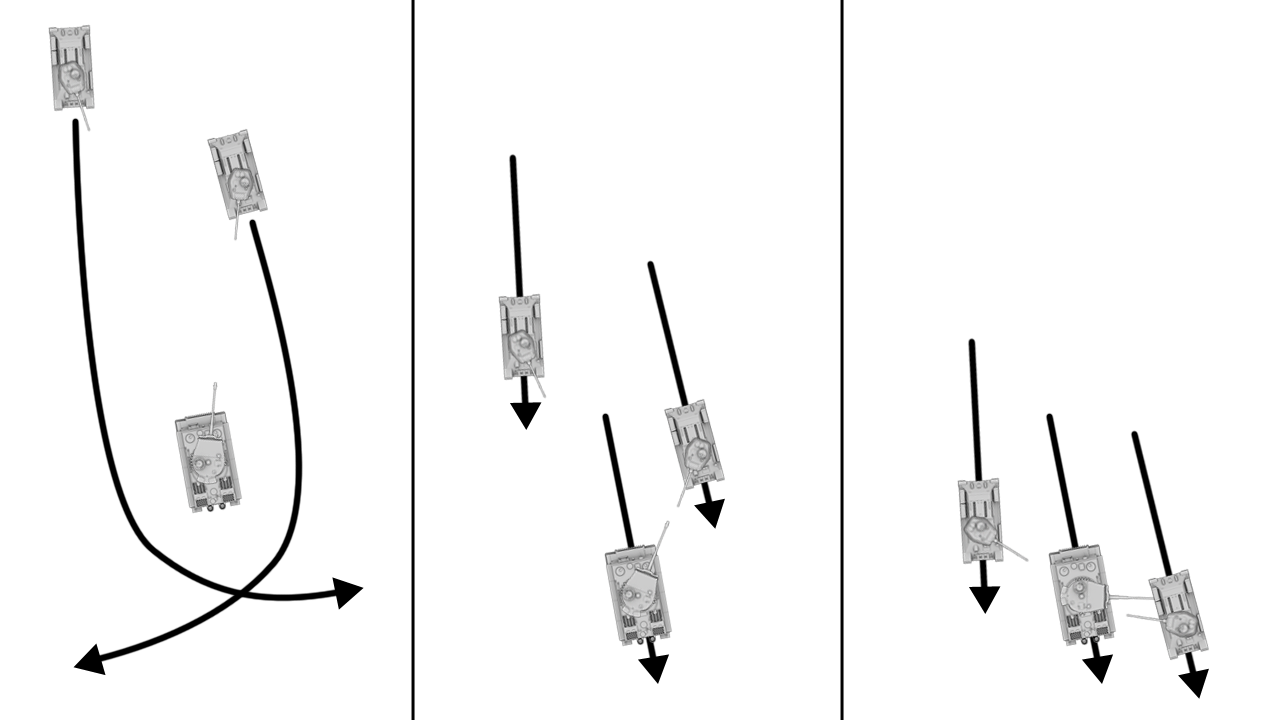 Don't allow yourself to be flanked - multiple targets / forward threat (more common). When multiple enemies are attempting to flank you or you're about to be flanked while there's the threat of enemy fire from forward your position, simply reverse, keeping your front armor facing the most serious threat (whether that be one of the flanking tanks or a sniping tank directly in front). This will delay the enemy from flanking your rear, allowing you to get shots off in the mean time. Remember to concentrate your damage on one target until it's gone or you are.
Don't allow yourself to be flanked - multiple targets / forward threat (more common). When multiple enemies are attempting to flank you or you're about to be flanked while there's the threat of enemy fire from forward your position, simply reverse, keeping your front armor facing the most serious threat (whether that be one of the flanking tanks or a sniping tank directly in front). This will delay the enemy from flanking your rear, allowing you to get shots off in the mean time. Remember to concentrate your damage on one target until it's gone or you are.
By tracking your enemy, you'll "stop them in their tracks." Tracking (short for "De-Tracking"), or destroying the tracks, renders a tank immobile until the crew is able to repair it. You can track a tank by ramming it (dependent on the speed and weight of the "rammer" and "ramee") or firing upon the tracks. Tracking high priority targets in the open will make them vulnerable to artillery fire. If you have teammates behind you in a lane (like on a city map) and a tank pops out from a building/street in front of you...track it! Every tank sitting behind you can get a free shot, track it again, and hopefully destroy it before it can get behind cover again.
Attacking tank destroyers from the front can mean certain death due to their often both thick and sloped frontal armor and powerful forward-locked gun, but their weak side and rear armor and inability to shoot in any direction but forward means tracking them and maneuvering around them can make for an easy kill. Note that some US tank destroyers are equipped with slowly turning turrets, meaning you'll still have to move in a circle around your target, though due to the slow turrets, these TDs are still not much of a threat if tracked.
Your odds of survival increase when sticking together. Except for certain circumstances, supporting one another in groups is preferable to going rogue and venturing out by yourself. When you're together, you can deal more damage and spread the damage dealt, attacking and defending more effectively. This can mean staying together even if you don't agree with the strategy--a coordinated bad plan has a higher chance of success than an uncoordinated bad plan. What this doesn't mean is cluster en masse--when the majority of your team takes one route, it exposes other flanks, giving a coordinated enemy an easy victory.
Destroy one at a time. Targeting one enemy at a time until they're destroyed is better than targeting multiple tanks simultaneously, as it quickly removes that tank and its ability to deal damage, where as a half-damaged tank can still deal full damage.
Prioritize your targets. Know yourself. Are you a heavy tank, a medium tank, a TD? For example, as a heavy tank, you shouldn't waste time firing upon an "easy kill" when there's a more prevalent threat, such as an enemy heavy behind cover waiting to duck out and fire. Just the same, as a medium tank, don't waste your fire on targets you know you can't penetrate, go for the softer ones to support your heavies. An exception to this is when the "easy kill" target is scouting your position for enemy artillery or a heavy target is about to capture your base. In both cases, the tank has just become a bigger threat and primary target.
Use more armored friendlies as cover to avoid fire, especially when supporting heavy tanks against enemy heavies. Stay alive so you can continue to dish out damage and support your team. Be aware of their intentions and don't block their path to retreat behind cover.
Don't be predictable, it's easy to counter.
Fire ahead of fast moving targets. In World of Tanks, once fired, shots take an arcing path (gravity exists but the your aiming reticle accounts for the shell drop from gravity, so aim for what you want to hit) over a certain time (dependent on distance and shell velocity, slower shells have a higher arc, while faster shells have a lower). This delay means you must aim a certain distance in front of the target's path depending on the target's speed and distance from you--called the Angle of Deflection. If calculated properly, the shell will reach its target just as the enemy drives into your line of fire. Shell Speed and tank speed are a relatively small factor in the equation to lead a tank. But your Lag is a much bigger factor when firing at a rapidly moving tank.
Don't be afraid to run away. If your strategy is failing or you're against impossible odds, instead of suicide rushing toward the enemy, retreat, regroup and change your strategy.
Continue to coordinate your attack as events develop. In the example above, as the two enemy heavy tanks are distracted, medium tanks take a flank position. Split into groups and work together to overpower the enemy in a coordinated effort. Use cover, camouflage, terrain and the abilities of the tanks at hand to your advantage.
Keep it moving on open terrain. Exposed , a sitting tank is a soon-to-be-scrap tank. Slow or stop, quickly aim and fire, then continue to take up a better position against the enemy while reloading. If you stand still, you'll be easy prey for enemy tanks and artillery.
Armor Angling
Slant your armor to decrease the angle of impact. Slanting your tank (30-40 degrees) toward an enemy will decrease the angle of impact and improve the chances the round will fail to penetrate (ricochet). Be aware, this can increase your angle of impact for an enemy to the far right or far left forward your position, which is why it's best used in tighter spaces or one-on-one combat.
Hug the edge while rounding cover to expose yourself to as little enemy fire as possible. In areas where tanks will build up on opposite sides of a ridge, running out into the open is certain death. If you're unable to help duke it out while rounding the ridge, try changing your tactics and taking a different route.
Beware enemy baiting tactics and learn how to use them to your advantage. You may get more than you bargained for by cresting a ridge or moving through a choke point to get to a tasty kill. Know how to spot obvious baiting, note enemy behavior and the map for potential sniper locations.
Other Tactics
Sidescraping/Reverse angling
Main page: Tactics: Sidescraping and Reverse Angling
An alternative to moving the front of your tank slightly around a corner, firing, and then backing up again ("Peek-a-boo") is to maneuver your tank into what's referred to on the forums as the Sidescrape Position. In this position you expose the side of your tank rather than the front, at an angle that presents a very high chance of a ricochet. You also do not move in and out of cover. On German tanks especially, this avoids exposing the front of the tank and potentially taking engine hits. Under many circumstances, this position offers more protection. Just be aware of the enemy(ies) you're facing and the potential downsides.
The reverse angling technique is a variant in which the tank is presenting with its rear oriented towards the opponent. It is normally used on front-mounted turret tanks in order to create better angling for sidescrapes. A good example of tanks suited for reverse-angles is the T29, T32, and T34 heavy tanks.
The main downsides are:
- It can only be used when alone.
- You can't move completely behind cover between shots.
- The entire side of your tank is exposed to artillery splash damage.
- The angle doesn't help much against HE rounds.
Facehugging
Main article: Tactics: Facehugging
Often used when fighting one on one with other tanks. Drive into the face of an enemy opponent and stay there while trading shots, not letting them back up or maneuver around you. This tactic is often a good idea when playing higher tier American tanks against tanks of other nations, or when playing as tank destroyers. They are forced to try to penetrate your tough frontal turret armor or hit your small cupola (which can be avoided by swinging your turret from side to side) while with your good gun depression you can fire onto their upper plate, which is now nearly horizontal. This tactic can often only be used against tanks of similar sizes, as being larger lets the enemy tank shoot your frontal plate while being smaller lets them shoot the top of your turret. Do note that this method is not a good idea for many French tanks, which have weak turrets but strong hulls.
Crackpot Tactics
Main article: Tactics: Crackpot Tactics
These are high risk tactics with no basis in reality.

